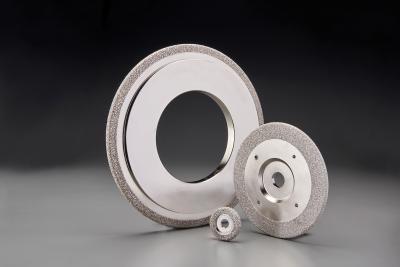
Saint-Gobain Abrasives, one of the world’s largest abrasives manufacturers, announced the introduction of its new patent-pending Norton Winter Ironclad™ Diamond Single Layer Superabrasive Wheels that achieve maximum material removal for increased productivity, especially when used in automated grinding cells. Featuring the strongest and most durable bond on the market, Ironclad wheels finish up to 50% more parts per wheel compared with electroplated wheels. Norton Winter Ironclad Wheels are a superior solution for ductile and grey cast iron applications such as fettling and snag grinding on casting gates, parting lines, sprues, and more.
"The advanced, high performance bond has up to 75% grain exposure, offering heat resistance and lubricity to achieve larger depths-of-cut and cooler cutting," said Andy Schoch, Product Manager for Single Layer Products, Norton│Saint-Gobain Abrasives. "The unique bond also reduces friction, allowing for lower grinding power. Norton Winter Ironclad Wheels provide significantly higher stock removal rates and a lower cost per part compared to other standard plated products." The new wheels produce more burr-free parts, minimizing secondary operations.
Norton Winter Ironclad Wheels offer several additional benefits including reduced downtime due to longer wheel life which extends time between setups. There is less bluing of castings even towards the end of the wheel life. Promoting a cleaner, healthier work environment, the new wheels generate significantly less dust and odor compared with traditional bonded wheels.
No wheel dressing is required and the rigid steel hub reduces vibration during CNC grinding. A known grinding wheel location facilitates easier programming, and a rigid steel hub reduces vibration resulting in consistent wheel dimensions and minimal wheel wear.
All Norton Winter Ironclad Wheels are made to order to meet precise requirements. The wheels are available in a variety of profile shapes and wheel sizes suitable for a range of grinding cast iron parts.
Contact Details
Related Glossary Terms
- computer numerical control ( CNC)
computer numerical control ( CNC)
Microprocessor-based controller dedicated to a machine tool that permits the creation or modification of parts. Programmed numerical control activates the machine’s servos and spindle drives and controls the various machining operations. See DNC, direct numerical control; NC, numerical control.
- dressing
dressing
Removal of undesirable materials from “loaded” grinding wheels using a single- or multi-point diamond or other tool. The process also exposes unused, sharp abrasive points. See loading; truing.
- grinding
grinding
Machining operation in which material is removed from the workpiece by a powered abrasive wheel, stone, belt, paste, sheet, compound, slurry, etc. Takes various forms: surface grinding (creates flat and/or squared surfaces); cylindrical grinding (for external cylindrical and tapered shapes, fillets, undercuts, etc.); centerless grinding; chamfering; thread and form grinding; tool and cutter grinding; offhand grinding; lapping and polishing (grinding with extremely fine grits to create ultrasmooth surfaces); honing; and disc grinding.
- grinding wheel
grinding wheel
Wheel formed from abrasive material mixed in a suitable matrix. Takes a variety of shapes but falls into two basic categories: one that cuts on its periphery, as in reciprocating grinding, and one that cuts on its side or face, as in tool and cutter grinding.
- lubricity
lubricity
Measure of the relative efficiency with which a cutting fluid or lubricant reduces friction between surfaces.
- parting
parting
When used in lathe or screw-machine operations, this process separates a completed part from chuck-held or collet-fed stock by means of a very narrow, flat-end cutting, or parting, tool.
